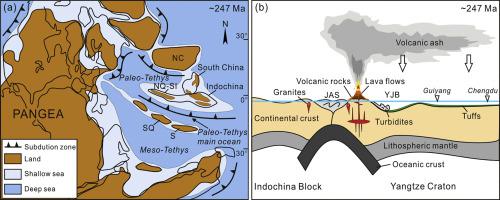Gondwana Research ( IF 7.2 ) Pub Date : 2021-02-06 , DOI: 10.1016/j.gr.2020.12.030 Wenjie Li , Zejin Shi , Guan Yin , Yaming Tian , Yong Wang , Jin Zhang

|
The tuff layer steadily distributed in the western Yangtze Craton is a regional marker for the Early–Middle Triassic (Olenekian–Anisian) boundary. Integrated studies of whole-rock geochemistry and zircon geochronology reveal that the parental magma of the tuff is of felsic composition, generated via volcanic eruptions in the continental arc setting along the southwestern margin of the Yangtze Craton at ~247 Ma. The syn-depositional zircons in the tuff layers and in the coeval igneous rocks exhibit uniform negative εHf(t) values of approximately −20 to −6, indicating the significant input of crustal materials. Massive crustal assimilation implies a large-scale remelting of the pre-existing continental crust, triggered by the intensive arc–continental collision during that time. This intensive collisional tectonomagmatic event is an important signal for the closing of the eastern Paleo-Tethys branch and points to the initial collision of the Indochina Block and the Yangtze Craton. Xenocrystic zircons in the Precambrian-age offer insight into the early evolution of the southwestern Yangtze Craton, which shows episodic crustal growth and reworking of ~2.9–2.2 Ga, crustal reworking of ~1.9–1.7 Ga, rifting-related tectonomagmatism of ~1.6–1.4 Ga, and crustal growth of ~1.1–0.8 Ga. The older crystallization ages (3.4–2.5 Ga), lower initial 176Hf/177Hf values (0.2805–0.2813), negative εHf(t) values (−15.7 to −1.6), and two-stage Hf model ages (3.9–2.8 Ga) of zircons further suggest that an unexposed Archean basement exists beneath the southwestern Yangtze Craton. Significant contributions of mantle-derived materials occur at ~1.3–1.0 Ga, implying that the southwestern Yangtze Craton may not be involved in the Grenvillian-aged continental–continental collision orogeny. Comparable age spectrums and Hf isotopic data suggest that the Paleoproterozoic igneous rocks are a non-negligible provenance for Proterozoic metasedimentary in the Kangdian region.
中文翻译:

扬子克拉通西部中部早三叠世凝灰岩的起源和构造意义:对全岩石地球化学和锆石U-Pb和Hf同位素特征的认识
扬子克拉通西部稳定分布的凝灰岩层是早中三叠世(奥列尼克-阿尼西亚)边界的区域标志。对全岩石地球化学和锆石年代学的综合研究表明,凝灰岩的母岩浆具有长英质成分,是由扬子克拉通西南缘约247 Ma的大陆弧环境中的火山喷发产生的。所述顺式在凝灰岩层和在同时代火成岩-depositional锆石显示出均匀的负ε的Hf(吨)值约为-20至-6,表明大量地壳物质输入。大规模的地壳同化意味着在此期间强烈的弧-陆碰撞引发了先前存在的大陆壳的大规模重熔。强烈的构造碰撞学事件是东部古特提斯分公司关闭的重要信号,并指出印度支那地块和扬子克拉通的初始碰撞。前寒武纪的异晶锆石为西南扬子克拉通的早期演化提供了见识,它显示了地壳的典型生长和返工约2.9-2.2 Ga,返工地壳约1.9-1.7 Ga,与裂谷有关的构造学特征为约1.6-。 1.4 Ga,地壳生长〜1.1–0.8 Ga。较早的结晶年龄(3.4–2.5 Ga),较低的初始176HF / 177的Hf值(0.2805-0.2813),负ε的Hf(吨)的值(-15.7 -1.6),和锆石的两阶段的Hf模式年龄(3.9-2.8 Ga)的进一步表明,未曝光太古代基底之下存在西南扬子。地幔源物质的重大贡献发生在〜1.3–1.0 Ga处,这意味着西南扬子克拉通可能不参与格伦维利时代的大陆-大陆碰撞造山运动。可比的年龄谱和H同位素数据表明,古元古代火成岩是康甸地区元古代变质沉积的不可忽视的起源。











































 京公网安备 11010802027423号
京公网安备 11010802027423号